Estimation of Biophysical Parameters of Forage Cactus Under Different Agricultural Systems Through Vegetation Indices and Machine Learning Using RGB Images Acquired with Unmanned Aerial Vehicles
Abstract
1. Introduction
2. Materials and Methods
2.1. Site Description
2.2. Experimental Design and Crop Management
2.2.1. Experimental Unit I and II: Different Planting Densities with East–West and North–South Orientation
2.2.2. Experimental Unit III: Different Rows Spacings
2.2.3. Experimental Unit VI: Cutting Frequencies
2.3. Unmanned Aerial Vehicle Flight Pattern
2.4. Orthomosaic and Vegetation Indices
2.5. Obtaining Data In Situ
2.5.1. Structural Characteristics of Forage Cactus
2.5.2. Agronomic Characteristics of Forage Cactus
2.6. Statistical Analysis
3. Results
3.1. Spearman’s Correlation Analysis of Biophysical Parameters and Vegetation Indices
3.2. Model Prediction Analysis
3.2.1. Different Planting Densities with East–West and North–South Orientation
3.2.2. Different Planting Densities (Row Spacing)
3.2.3. Cutting Frequencies and Different Forage Cactus Clones
4. Discussion
5. Conclusions
Author Contributions
Funding
Institutional Review Board Statement
Data Availability Statement
Acknowledgments
Conflicts of Interest
References
- Omia, E.; Bae, H.; Park, E.; Kim, M.S.; Baek, I.; Cho, B.-K. Remote sensing in field crop monitoring: A comprehensive review of sensor systems, data analyses and recent advances. Remote Sens. 2023, 15, 354. [Google Scholar] [CrossRef]
- Killlen, P.; Kiringa, I.; Yeap, T.; Branco, P. Corn grain yield prediction using UAV-Based high spatiotemporal resolution imagery, machine learning, and spatial cross-validation. Remote Sens. 2024, 16, 683. [Google Scholar] [CrossRef]
- Júnior, G.N.A.; Jardim, A.M.d.R.F.; Silva, M.J.; Alves, C.P.; Souza, C.A.A.d.; Costa, S.A.T.; Cunha, M.V.; Simões, A.d.N.; Silva, J.R.I.; Souza, L.S.B.d.; et al. Growth dynamics and accumulation of forage mass of forage cactus clones as affected by meteorological variables and water regime. Eur. J. Agron. 2021, 131, 126375. [Google Scholar] [CrossRef]
- Jardim, A.M.d.R.F.; Souza, L.S.B.d.; Alves, C.P.; Araújo, J.F.N.d.; Souza, C.A.A.d.; Pinheiro, A.G.; Araújo, G.G.L.d.; Campos, F.S.; Tabosa, J.N.; Silva, T.G.F.d. Intercropping forage cactus with sorghum affects the morphophysiology and phenology of forage cactus. Afr. J. Range Forage Sci. 2021, 40, 129–140. [Google Scholar] [CrossRef]
- Alves, C.P.; Jardim, A.M.d.R.F.; Araújo Júnior, G.d.N.; de Souza, L.S.B.; Araújo, G.G.L.; de Souza, C.A.A.; Salvador, K.R.d.S.; Leite, R.M.C.; Pinheiro, A.G.; da Silva, T.G.F. How to enhance the agronomic performance of cactus-sorghum intercropped system: Planting configurations, density and orientation. Ind. Crops Prod. 2022, 184, 115059. [Google Scholar] [CrossRef]
- Silva, N.M.G.; Santos, M.V.F.; Dubeux Júnior, J.C.B.; Cunha, M.V.; Lira, M.A.; Ferraz, I. Effects planting density and organic fertilization doses on productive efficiency of cactus pear. Rev. Caatinga 2016, 29, 976–983. [Google Scholar] [CrossRef]
- Souza, T.C.; Santos, M.V.F.; Dubeux Júnior, J.C.B.; Lira, M.A.; Santos, D.C.d.; Cunha, M.V.; Lima, L.E.; Silva, R.R. Productivity and nutrient concetration in spineless cactus under different fertilizations and plant densities. Rev. Bras. Ciências Agrárias 2017, 12, 555–560. [Google Scholar] [CrossRef]
- Peixoto, M.J.A.; Carneiro, M.S.S.; Amorim, D.S.; Edvan, R.L.; Pereira, E.S.; Costa, M.R.G.F. Caracteristicas agronômicas e composição química da palma forrageira em função de diferentes sistemas de plantio. Arch. Zootec. 2018, 67, 35–39. [Google Scholar] [CrossRef][Green Version]
- Alves, H.K.M.N.; Silva, T.G.F.d.; Jardim, A.M.d.R.F.; Souza, L.S.B.d.; Araújo Júnior, G.N.; Souza, C.A.A.d.; Moura, M.B.S.d.; Araújo, G.G.L.d.; Campos, F.S.; Cruz Neto, J.F. The use of mulch in cultivating the forage cactus optimizes yield in less time and increases the water use efficiency of the crop. Irrig. Drain 2023, 72, 75–89. [Google Scholar] [CrossRef]
- Souza, M.d.S.; Silva, T.G.F.d.; Souza, L.S.B.d.; Alves, H.K.M.N.; Leite, R.M.C.; Souza, C.A.A.d.; Araujo, G.G.L.d.; Campos, F.S.; Silva, M.J.d.; Souza, P.J.D.O.p.d. Growth, phenology and harvesting time of cactus-millet intercropping system under biotic mulching. Arch. Agron. Soil Sci. 2022, 68, 764–778. [Google Scholar] [CrossRef]
- Silva, G.I.N.d.; Morais, J.E.F.d.; Souza, C.A.A.d.; Jardim, A.M.d.R.F.; Salvador, K.R.d.S.; Souza, L.S.B.d.; Simões, A.d.N.; Campos, F.S.; Steidle Neto, A.J.; Silveira, A.V.M.; et al. Do different densities ans planting orientations of forage cactus alter agronomic, morphophysiological characteristics, and soil water dynamics in a semiarid region? Eur. J. Agron. 2024, 159, 127271. [Google Scholar] [CrossRef]
- Barbosa, B.D.S.; Ferraz, G.A.S.; Gonçalves, L.M.; Marin, D.B.; Maciel, D.T.; Ferraz, P.F.P.; Rossi, G. RGB vegetation indices applied to grass monitoring: A qualitative analysis. Agronomy 2019, 17, 349–357. [Google Scholar] [CrossRef]
- Caron, M.L.; Minuzzi, R.B. Estimativa de produtividade da soja com uso de perfis temporais de índices de vegetação do sensor MODIS em Sapezal, Mato Grosso. Rev. Bras. Geogr. Física 2022, 15, 1660–1675. [Google Scholar] [CrossRef]
- Sobrinho Neto, F.S.; Danelichen, V.H.M. Estudo do uso de índices de vegetação nas culturas do Brasil. Uniciências 2022, 26, 100–107. [Google Scholar] [CrossRef]
- Oliveira, H.F.E.d.; Castro, L.E.V.; Sousa, C.M.; Alves Júnior, L.R.; Mesquita, M.; Silva, J.A.O.S.; Faria, L.C.; Silva, M.V.d.; Giongo, P.R.; Oliveira Júnior, J.F.; et al. Geotechnologies in biophysical analysis through the applicability of the UA Vans Sentinel-2A/MSI in irrigated area of common beans: Accuracy and spatial dynamics. Remote Sens. 2024, 16, 1254. [Google Scholar] [CrossRef]
- Arantes, L.R.; Arantes, B.H.T.; Giongo, P.R.; Ceccato, G.Z.; Moraes, V.H.; Saito, Y.K.; Gomes, L.F.; Oliveira-Castro, A.C. Comportamento espectral e detecção de laranjeiras (Citrus sinensis L. Osbeck) com estresse hídrico, por meio de drone. Rev. Bras. Geogr. Física 2020, 13, 3625–3635. [Google Scholar] [CrossRef]
- Andrade, O.B.; Montenegro, A.A.A.; Silva Neto, M.A.; Sousa, L.B.; Almeida, T.A.B.; Lima, J.L.M.P.; de Carvalho, A.A.; da Silva, M.V.; Medeiros, V.W.C.; Soares, R.G.F.; et al. UAV-Based classification of intercropped forage cactus: A comparison of RGB and multispectral sample spaces using machine learning in an irrigated area. AgriEngimeering 2024, 6, 509–525. [Google Scholar] [CrossRef]
- Shao, G.; Han, W.; Zhang, H.; Zhang, L.; Wang, Y.; Zhang, Y. Prediction of maize crop coefficient from UAV multisensor remote sensing using machine learning methods. Agric. Water Manangement 2023, 276, 108064. [Google Scholar] [CrossRef]
- Cao, X.; Liu, Y.; Yu, R.; Han, D.; Su, B. A comparison of UAV RGB and multispectral imaging in phenotyping for stay green of wheat population. Remote Sens. 2021, 13, 5173. [Google Scholar] [CrossRef]
- Agência Nacional de Aviação Cívil (ANAC). Regulamento Brasileiro da aviação civil (RBAC-E) N° 94. Diário Of. União 2021, 117, 1–34. [Google Scholar]
- Shanmugapriya, P.; Rathika, S.; Ramesh, T.; Janaki, P. Applications of remote sensing in agriculture–a review. Int. J. Curr. Microbiol. Appl. Sci. 2019, 8, 2270–2283. [Google Scholar] [CrossRef]
- Istiak, M.d.A.; Syeed, M.M.M.; Hossaim, M.d.S.; Uddin, M.F.; Hasan, M.; Khan, R.H.; Azad, N.S. Adoption of unmanned aerial vehicle (UAV) imagery in agricultural management: A systematic literature review. Ecol. Inform. 2023, 78, 102305. [Google Scholar] [CrossRef]
- Iqbal, I.M.; Balzter, H.; Bareen, F.; Shabbir, A. Mapping Lantana camara and Leucaena leucocephala in protected areas of Pakistan: A geo-spatial approach. Remote Sens. 2022, 15, 1020. [Google Scholar] [CrossRef]
- Lourenço, V.R.; Montenegro, A.A.d.A.; de Carvalho, A.A.; Souza, L.B.; Almeida, T.A.B.; Almeida, T.F.S.; Vilar, B.P. Spatial variability of biophysical multiespectral index under heterogeneity and anisotropy for precision monitoring. Rev. Bras. Eng. Agrícola E Ambient. 2023, 27, 848–857. [Google Scholar] [CrossRef]
- Vigneault, P.; Lafond-Lapalme, J.; Deshaies, A.; Khun, K.; La Sablonniere, S.; Filion, M.; Longchamps, L.; Mimee, B. An integrated data-driven approach to monitor and estimate plant-scale growth using UAV. Open J. Photogramm. Remote Sens. 2024, 11, 100052. [Google Scholar] [CrossRef]
- Freire-Silva, J.; Paz, Y.M.; Lima-Silva, P.P.; Pereira, J.P.A.; Candeias, A.L.B. Remote sensing vegetation index for processing images in the visible band (RGB). J. Hyperpectral Remote Sens. 2019, 9, 228–239. [Google Scholar] [CrossRef]
- Andrade, M.; Teodoro, L.P.R.; Baio, F.H.R.; Campos, C.N.S.; Roque, C.G.; Silva Júnior, C.A.; Coradi, P.C.; Teodoro, P.E. High-throughput phenotyping of soybean genotypes under base saturation stress conditions. J. Agron. Crop Sci. 2021, 207, 163–169. [Google Scholar] [CrossRef]
- Adar, S.; Sternberg, M.; Paz-Kagan, T.; Henkin, Z.; Dovrat, G.; Zaady, E.; Argaman, E. Estimation of aboveground biomass production using an unmanned aerial vehicle (UAV) and VENuS satellite imagery in Mediterranean and semiarid rangelands. Remote Sens. Appl. Soc. Environ. 2022, 26, 100753. [Google Scholar] [CrossRef]
- Sapkota, B.; Singh, V.; Neely, C.; Rajan, N.; Bagavathinannan, M. Detection of italian ryegrass in wheat and prediction of competitive interactions using remote-sensing and machine-learning techniques. Remote Sens. 2020, 12, 2977. [Google Scholar] [CrossRef]
- Santos, W.M.; Costa, C.J.P.; Medeiros, M.L.S.; Jardim, A.M.d.R.F.; Cunha, M.V.; Dubeux Junior, J.C.B.; Jaramillo, D.M.; Bezerra, A.C.; Souza, E.J.O. Can unmanned aerial vehicle imagens be used estimate forage production parameters in agroforestry systems in the caatinga? Appl. Sci. 2024, 14, 4896. [Google Scholar] [CrossRef]
- Jamshidi, E.J.; Yusup, Y.; Hooy, C.W.; Kamaruddin, M.N.; Hassan, H.M.; Muhammad, S.A.; Shafri, H.Z.M.; Then, K.H.; Norizan, M.S.; Tan, C.C. Prediction oil palm yield usin a comprehensive agronomy dataset and 17 machine learning and deep learning models. Ecol. Inform. 2024, 81, 102595. [Google Scholar] [CrossRef]
- Gómez, D.; Salvador, P.; Sanz, J.; Casanova, J.L. Potato yield prediction using machine learnig techniques and Sentinel 2 data. Remote Sens. 2019, 11, 1745. [Google Scholar] [CrossRef]
- van Klompenburg, T.; Kassahun, A.; Catal, C. Crop yield prediction using machine learnig: A systematic literature review. Comput. Electron. Agric. 2020, 177, 105709. [Google Scholar] [CrossRef]
- Alvares, C.A.; Stape, J.L.; Sentelhas, P.C.; Gonçalves, J.L.d.M.; Sparovek, G. Köppen’s climate classification map for Brazil. Meteorol. Z. 2013, 22, 711–728. [Google Scholar] [CrossRef]
- Pereira, P.D.C.; da Silva, T.G.F.; Zolnier, S.; de Morais, J.E.F.; dos Santos, D.C. Morfogênese da palma forrageira irrigada por gotejamento. Rev. Caatinga 2015, 28, 184–195. [Google Scholar] [CrossRef]
- Silva, G.I.N.d.; Jardim, A.M.d.R.F.; Souza, M.d.S.; Araújo Júnior, G.d.N.; de Souza, L.S.B.; de Souza, C.A.A.; Alves, C.P.; de Araújo, G.G.L.; Montenegro, A.A.d.A.; Lima, B.L.d.C.; et al. Combined agricultural practices in millet and cactus: Phyllochron, structural characteristics and relations with yield. Sci. Agrícola 2023, 80, e20220046. [Google Scholar] [CrossRef]
- Allen, R.G.; Pereira, L.S.; Raes, D.; Smith, M. Crop Evapotranspiration: Guidelines for Computing Crop Water Requirements; Food and Agriculture Organization of The United Nations: Rome, Italy, 1998. [Google Scholar]
- Queiroz, M.G.; da Silva, T.G.F.; Zolnier, S.; Silva, S.M.S.; de Souza, C.A.A.; Carvalho, H.F.d.S. Relações hídrico-econômicas da palma forrageira cultivada em ambiente semiárido. Irriga 2016, 1, 141–154. [Google Scholar] [CrossRef]
- Jain, A.; Mahajan, M.; Saraf, R. Standardizitation of the Shape Ground control point (GCP) and the methodology for its detection in images for UAV-based mapping applications. In Proceedings of the Advances in Computer Vision; Arai, K., Kapoor, S., Eds.; Springer International Publishing: Cham, Switzerland, 2020; pp. 459–476. [Google Scholar]
- Gitelson, A.A.; Kaufman, Y.J.; Stark, R.; Rundquist, D. Novel algorithms for remote estimation of vegetation fraction. Remote Sens. Environ. 2002, 80, 76–87. [Google Scholar] [CrossRef]
- Bendig, J.; Yu, K.; Aasen, H.; Bolten, A.; Bennertz, S.; Broscheit, J.; Gnyp, M.L.; Bareth, G. Combining UAV-Based Plant Heightfrom Crop Surface Models, Visible, and near Infrared Vegetation Indices for Biomass Monitoring in Barley. Int. J. Appl. Earth Obs. Geoinf. 2015, 39, 79–87. [Google Scholar] [CrossRef]
- Louhaichi, M.; Borman, M.M.; Johnson, D.E. Spatially Located Platform and Aerial Photography for Documentation of GrazingImpacts on Wheat. Geocarto. Int. 2001, 16, 65–70. [Google Scholar] [CrossRef]
- Tucker, C.J. Red and photographic infrared linear combinations for monitoring vegetation. Remote Sens. Environ. 1979, 8, 127–150. [Google Scholar] [CrossRef]
- Meyer, G.E.; Camargo Neto, J. Verification of color vegetation indices for automated crop imaging applications. Comput. Electron. Agric. 2008, 63, 282–293. [Google Scholar] [CrossRef]
- Guijarro, M.; Pajares, G.; Riomoros, I.; Herrera, P. Automatic segmentation of relevant textures in agricultural images. Comput. Electron. Agric. 2011, 75, 75–83. [Google Scholar] [CrossRef]
- Camargo Neto, J. A Combined Statistical—Soft Computing Approach for Classification and Mapping Weed Species in Minimum Tillage Systems. Ph.D. Dissertation, University of Nebraska, Lincoln, NE, USA, 2004. [Google Scholar]
- Kataoka, T.; Kaneko, T.; Okamoto, H.; Hata, S. Crop growth estimation system using machine vision. In Proceedings of the 2003 IEEE/ASME International Conference on Advanced Intelligent Mechatronics, Kobe, Japan, 20–24 July 2003. [Google Scholar]
- Hague, T.; Tillett, N.D.; Wheeler, H. Automated crop and weed monitoring in widely spaced cereals. Precis. Agric. 2006, 7, 21–32. [Google Scholar] [CrossRef]
- Kawashima, S.; Nakatani, M. An algorithm for estimating chlorophyll content in leaves using a video camera. Ann. Bot. 1998, 81, 49–54. [Google Scholar] [CrossRef]
- Jardim, A.M.d.R.F.; da Silva, T.G.F.; de Souza, L.S.B.; Araújo Júnior, G.d.N.; Alves, H.K.M.N.; Souza, M.d.S.; de Araújo, G.G.L.; de Moura, M.S.B. Intercropping forage cactus and sorghum in a semi-arid environment improves biological efficiency and competitive ability through interspecific complementarity. J. Arid Environ. 2021, 188, 104464. [Google Scholar] [CrossRef]
- Pinheiro, K.M.; da Silva, T.G.F.; Carvalho, H.F.d.S.; Santos, J.E.O.; de Morais, J.E.F.; Zolnier, S.; dos Santos, D.C. Correlações do índice de área do cladódio com características morfogênicas e produtivas da palma forrageira. Pesqui. Agropecu. Bras. 2014, 49, 939–947. [Google Scholar] [CrossRef]
- Silva, T.G.F.; Araújo Primo, J.T.; de Morais, J.E.F.; Diniz, W.J.S.; de Souza, C.A.A.; Silva, M.C. Crescimento e produtividade de clones de palma forrageira no semiárido e relações com variáveis meteorológicas. Rev. Caatinga 2015, 28, 10–18. [Google Scholar]
- Matias, F.I.; Caraza-Harter, M.V.; Endelman, J.B. FIELDimageR: Na R package to analyze orthoosaic images from agricultural field trials. Plant Phenome J. 2020, 2, 190004. [Google Scholar] [CrossRef]
- Liaw, A.; Wiener, M. Classification and regression by randomForest. R News 2002, 2, 18–22. [Google Scholar]
- Kuhn, M.; Frick, H.H. Dials: Tools for Creating TUNING Parameter Values; R Package Version 1.3.0.9000; Posit Software, PBC: Boston, MA, USA, 2022; Available online: https://github.com/tidymodels/dials (accessed on 1 July 2024).
- Qiao, L.; Tang, W.; Gao, D.; Zhao, R.; An, L.; Li, M.; Sun, H.; Song, D. UAV-based chlorophyll content estimation by evaluating vegetation index responses under different crop coverages. Comput. Electron. Agric. 2022, 196, 106775. [Google Scholar] [CrossRef]
- Bareth, G.; Bolten, A.; Gnyp, M.L.; Reusch, S.; Jasper, J. Comparison of uncalibrated RGBVI with spectrometer-based NDVI derived from UAV sensing systems on field scale. Int. Arch. Photogramm. Remote Sens. Spat. Inf. Sci. 2016, 41, 837–843. [Google Scholar] [CrossRef]
- Possoch, M.; Bieker, S.; Hoffmeister, D.; Bolten, A.; Schellberg, J.; Bareth, G. Multi-Temporal Crop Surface Models Combined with the Rgb Vegetation Index from Uav-Based Images for Forage Monitoring in Grassland. Int. Arch. Photogramm. Remote Sens. Spat. Inf. Sci. 2016, 41, 991–998. [Google Scholar] [CrossRef]
- Lu, N.; Zhou, J.; Han, Z.; Li, D.; Cao, Q.; Yao, X.; Tian, Y.; Zhu, Y.; Cao, W.; Cheng, T. Improved estimation of aboveground biomass in wheat from RGB imagery and point cloud data acquired with a low-cost unmanned aerial vehicle system. Plant Methods 2019, 15, 17. [Google Scholar] [CrossRef]
- Lussem, U.; Bolten, A.; Gnyp, M.L.; Jasper, J.; Bareth, G. Evaluation of RGB-based vegetation indices from UAV imagery to estimate forage yield in Grassland. Int. Arch. Photogramm. Remote Sens. Spat. Inf. Sci. 2018, 42, 1215–1219. [Google Scholar] [CrossRef]
- Ruwanpathirana, P.P.; Sakai, K.; Jayasinghe, G.Y.; Nakandakari, T.; Yuge, K.; Wijekoon, W.M.C.J.; Priyankara, A.C.P.; Samaraweera, M.D.S.; Madushanka, P.L.A. Evaluation of Sugarcane Crop Growth Monitoring Using Vegetation Indices Derived from RGB-Based UAV Images and Machine Learning Models. Agronomy 2024, 14, 2059. [Google Scholar] [CrossRef]
- Hernandez, A.; Jensen, K.; Larson, S.; Larsen, R.; Rigby, C.; Johnson, B.; Spickermann, C.; Sinton, S. Using Unmanned Aerial Vehicles and Multispectral Sensors to Model Forage Yield for Grasses of Semiarid Landscapes. Grasses 2024, 3, 84–109. [Google Scholar] [CrossRef]
- Pan, T.; Ye, H.; Zhang, X.; Liao, X.; Wang, D.; Bayin, D.; Safafov, M.; Okhonniyozov, M.; Majid, G. Estimating aboveground biomass of grassland in central Asia mountainous areas using unmanned aerial vehicle vegetation indices and image textures—A case study of typical grassland in Tajikistan. Environ. Sustain. Indic. 2024, 22, 100345. [Google Scholar] [CrossRef]
- Bazzo, C.O.G.; Kamali, B.; Hütt, C.; Bareth, G.; Gaiser, T. A Review of Estimation Methods for Aboveground Biomass in Grasslands Using UAV. Remote Sens. 2023, 15, 639. [Google Scholar] [CrossRef]
- Defalque, G.; Santos, R.; Bungenstab, D.; Echeverría; Dias, A.; Defalque, C. Machine learning models for dry matter and biomass estimates on cattle grazing systems. Comp. Electron. Agric. 2024, 216, 108250. [Google Scholar] [CrossRef]
- Swaef, T.d.; Maes, W.H.; Aper, J.; Baert, J.; Cougnon, M.; Reheul, D.; Steppe, K.; Roldán-Ruiz, I.; Lootens, P. Applying rgb-and thermal-based vegetation indices from UAVs for high-throughput field phenotyping of drought tolerance in forage grasses. Remote Sens. 2021, 13, 147. [Google Scholar] [CrossRef]
- Souza, J.T.A.; Ribeiro, J.E.d.S.; Araújo, J.S.; Ramos, J.P.d.F.; do Nascimento, J.P.; de Medeiros, L.T.V. Gas exchanges and water-use efficiency of Nopalea cochenillifera intercropped under edaphic practices. Comun. Sci. 2020, 11, e3035. [Google Scholar] [CrossRef]
- Kior, A.; Yudina, L.; Zolin, Y.; Sukhov, V.; Sukhov, E. RGB imaging as a tool for remote sensing of characteristics of terrestrial plants: A review. Plants 2024, 13, 1262. [Google Scholar] [CrossRef]
- Ranđelović, P.; Đorđević, V.; Milić, S.; Balešević-Tubić, S.; Petrović, K.; Miladinović, J.; Đukić, V. Predection of soybean plant density using machine learning model and vegetation indices extracted from RGB images taken with a UAV. Agronomy 2020, 10, 1108. [Google Scholar] [CrossRef]
- Alves, K.S.; Guimarães, M.; Ascari, J.P.; Queiroz, M.F.; Alfenas, R.F.; Mizubiti, E.S.G.; Del Ponte, E.M. RGB-based phenotyping of foliar disease severity under controlled conditions. Trop. Plant Pathol. 2022, 47, 105–117. [Google Scholar] [CrossRef]
- Coswosk, G.C.; Gonçalves, V.M.L.; Lima, V.J.d.; Souza, G.A.R.d.; Amaral Júnior, A.T.d.; Pereira, M.G.; Oliveira, E.C.d.; Leite, J.T.; Kamphorst, S.H.; Oliveira, U.A.d.; et al. Utilizing visible ban vegetation indices from Unmanned Aerial Vehicle Images for maize phenotyping. Remote Sens. 2024, 16, 3015. [Google Scholar] [CrossRef]
- Breiman, L. Random Forest. Mach. Learn 2021, 45, 5–32. [Google Scholar] [CrossRef]
- Bai, T.; Sun, K.; Deng, S.; Li, D.; Li, W.; Chen, Y. Multi-scale hierarchical sampling change detection using Random Forest for high-resolution satellite imagery. Int. J. Remote Sens. 2018, 39, 7523–7546. [Google Scholar] [CrossRef]
- Ji, Y.; Chen, Z.; Cheng, Q.; Liu, R.; Li, M.; Yan, X.; Li, G.; Wang, D.; Fu, L.; Ma, Y.; et al. Estimation of plant height and yield based on UAV imagery in faba bean (Vicia faba L.). Plant Methods 2022, 18, 26. [Google Scholar] [CrossRef]
- Wang, N.; Guo, Y.; Wei, X.; Migtong, Z.; Wang, H.; Bai, Y. UAV – based remote sensing using visible and multispectral indices for the estimation of vegetation cover in an oasis of a desert. Ecol. Indic. 2022, 141, 109155. [Google Scholar] [CrossRef]
- Lussem, U.; Bolten, A.; Kleppert, I.d.; Jasper, J.; Gnyp, M.L.; Schellberg, J.; Bareth, J. Herbage mass, N concentration, and N uptake of temperature grasslands can adequately be estimated from UAV-based image data using machine learnig. Remote Sens. 2022, 14, 3066. [Google Scholar] [CrossRef]
- Grüner, E.; Astor, T.; Wachendorf, M. Biomass prediction of heterogeneus temperate grasslands using an SfM aproach based UAV imaging. Remote Sens. 2019, 9, 54. [Google Scholar] [CrossRef]
- García-Martínez, H.; Flores-Magdaleno, H.; Ascencio-Hernández, R.; Khalil-Gardezi, A.; Tijerina-Chávez, L.; Mancilla-Villa, O.R.; Vázquez-Peña, M.A. Corn grain yield estimation from vegetation índices, canopy cover, plant density, and a neural networking using multispectral and RGB images acquired with Unmanned Aerial Vehicles. Agriculture 2020, 10, 277. [Google Scholar] [CrossRef]
- Domingues, T.; Brandão, T.; Ferreira, J.C. Machine learning for detection and prediction of crop diseases and pets: A comprehensive survery. Agriculture 2022, 12, 1350. [Google Scholar] [CrossRef]
- Zhang, Z.C.; Xin, Q.; Li, W. Machine learning-based modeling of vegetation leaf area index and gross primary productivity across North America and comparison with a process-based model. J. Adv. Model. Earth Syst. 2021, 13, e2021MS002802. [Google Scholar] [CrossRef]
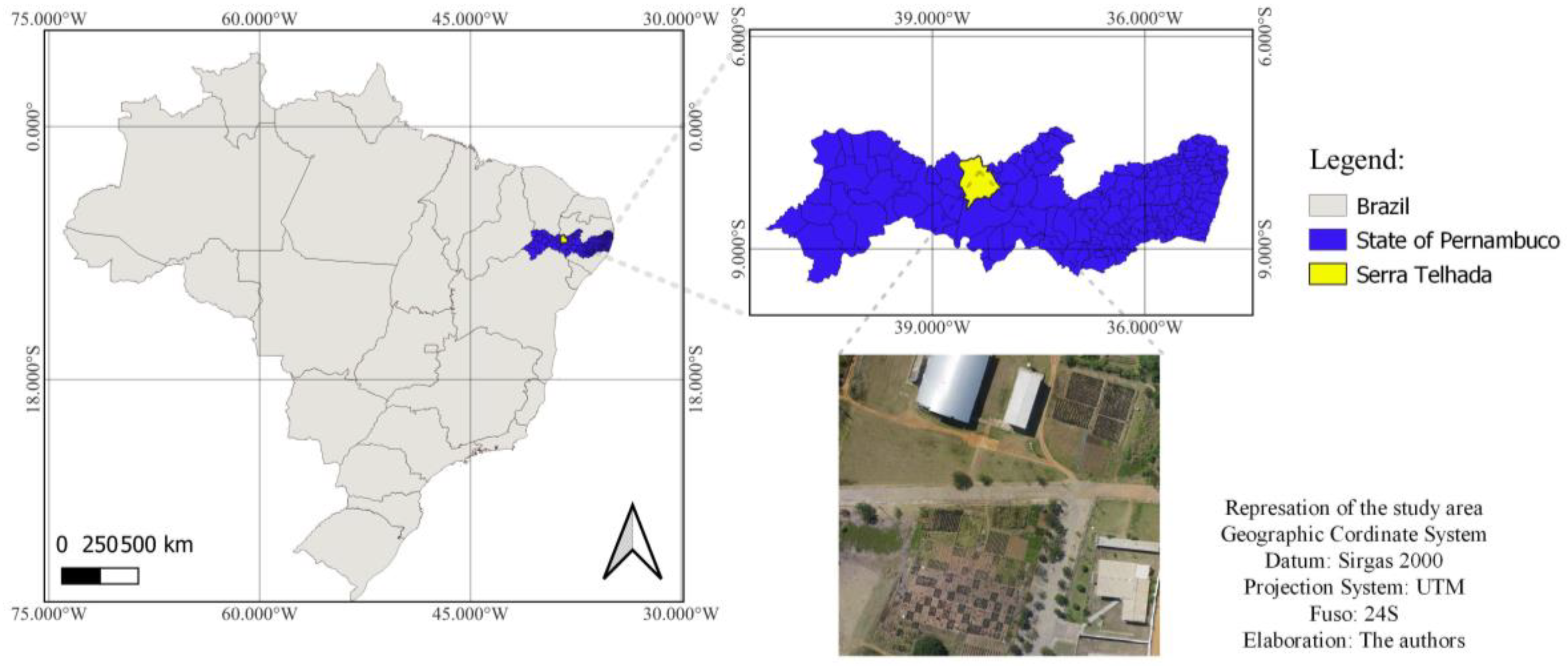
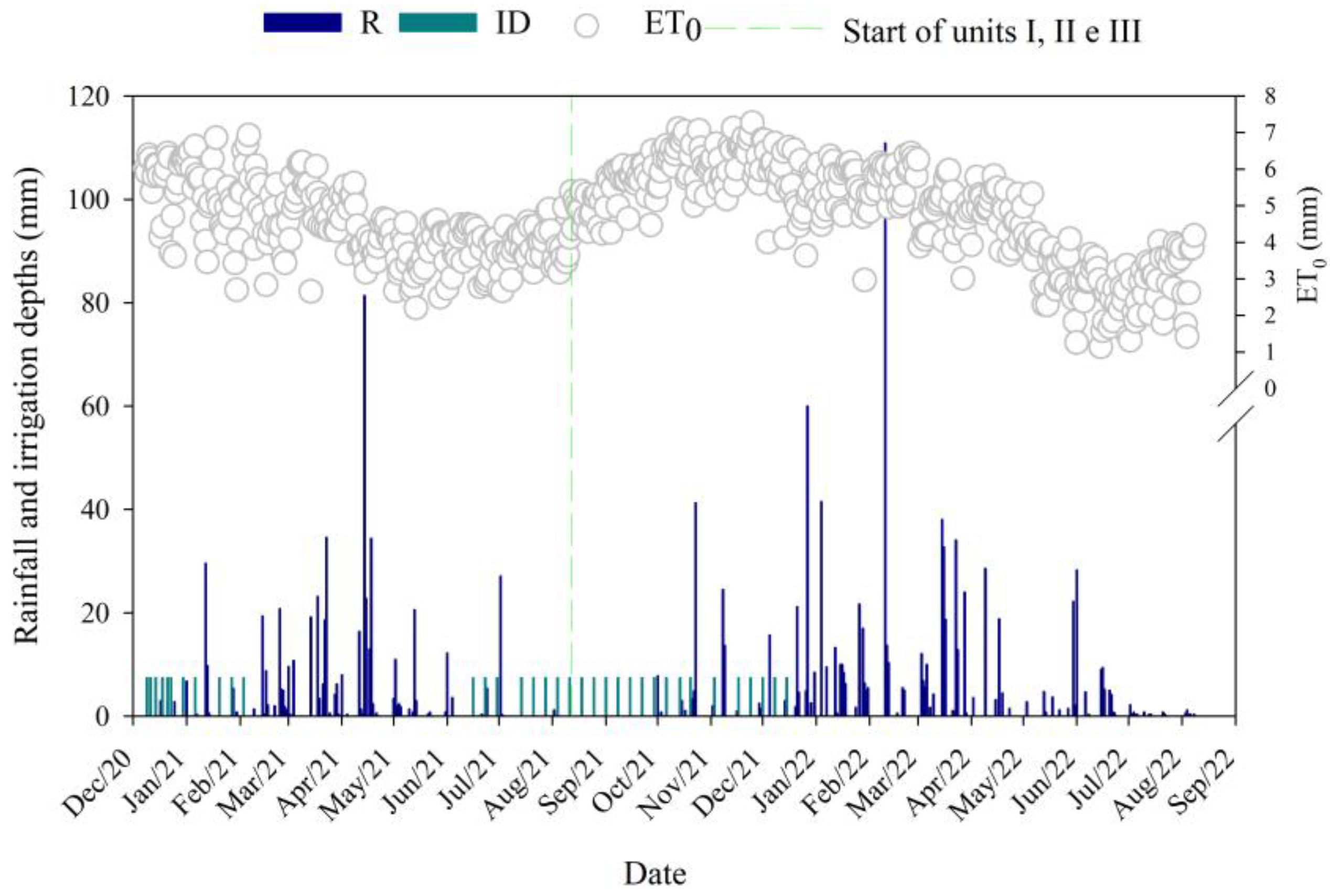
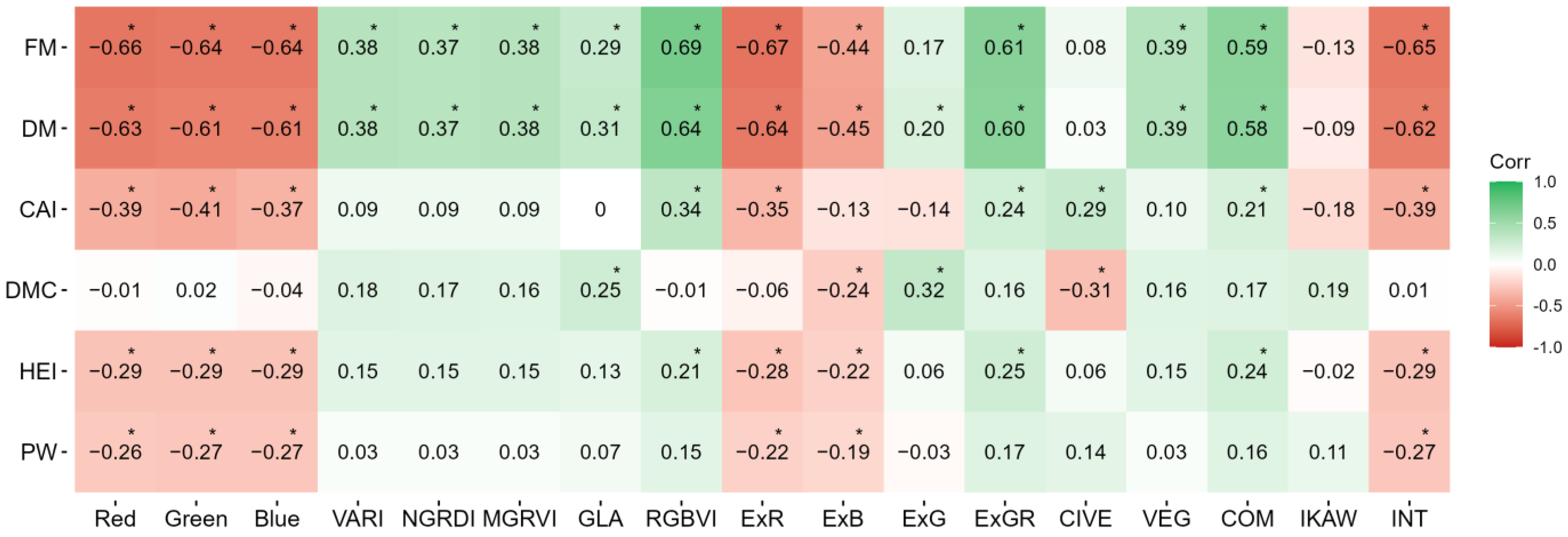
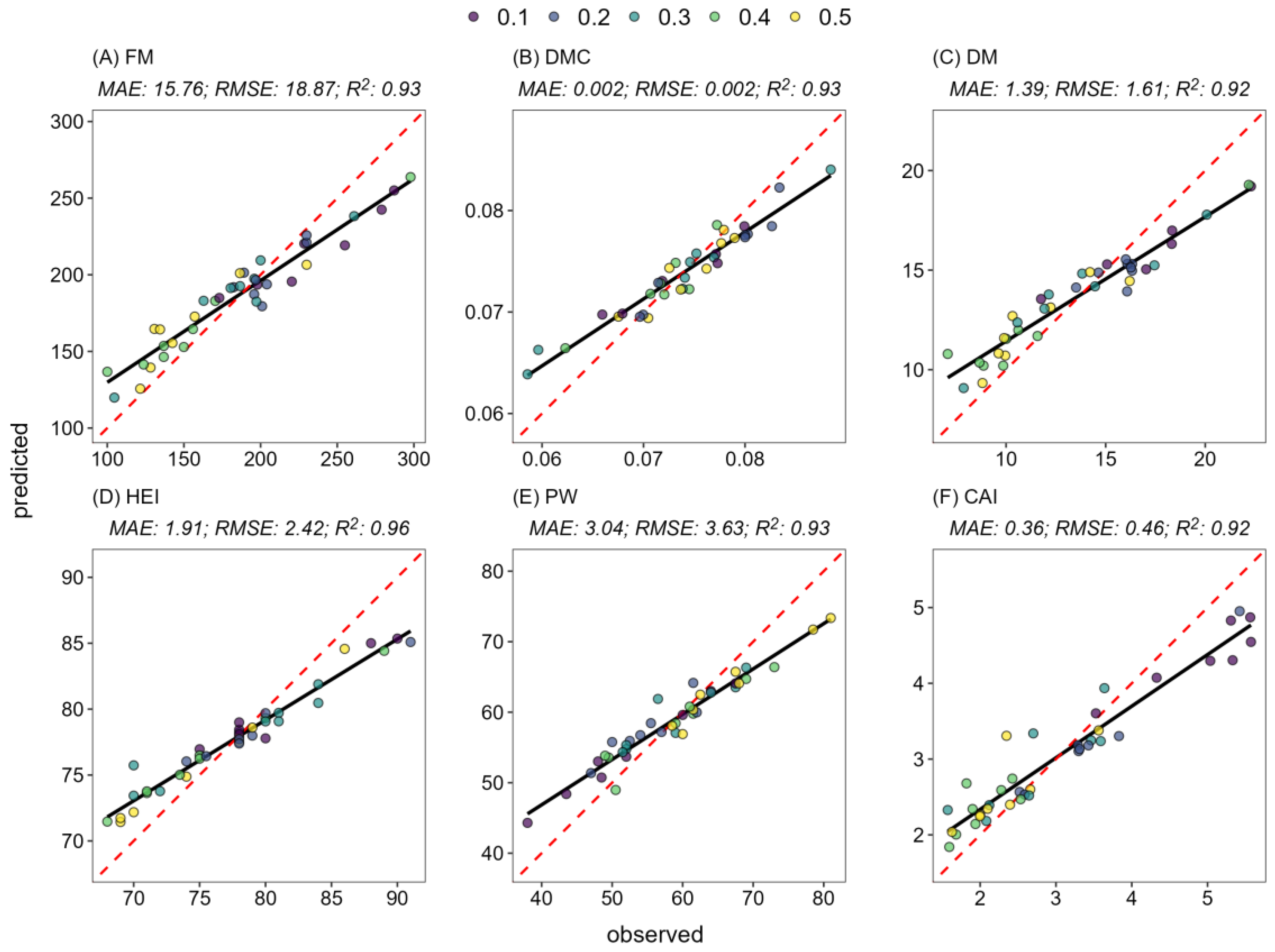
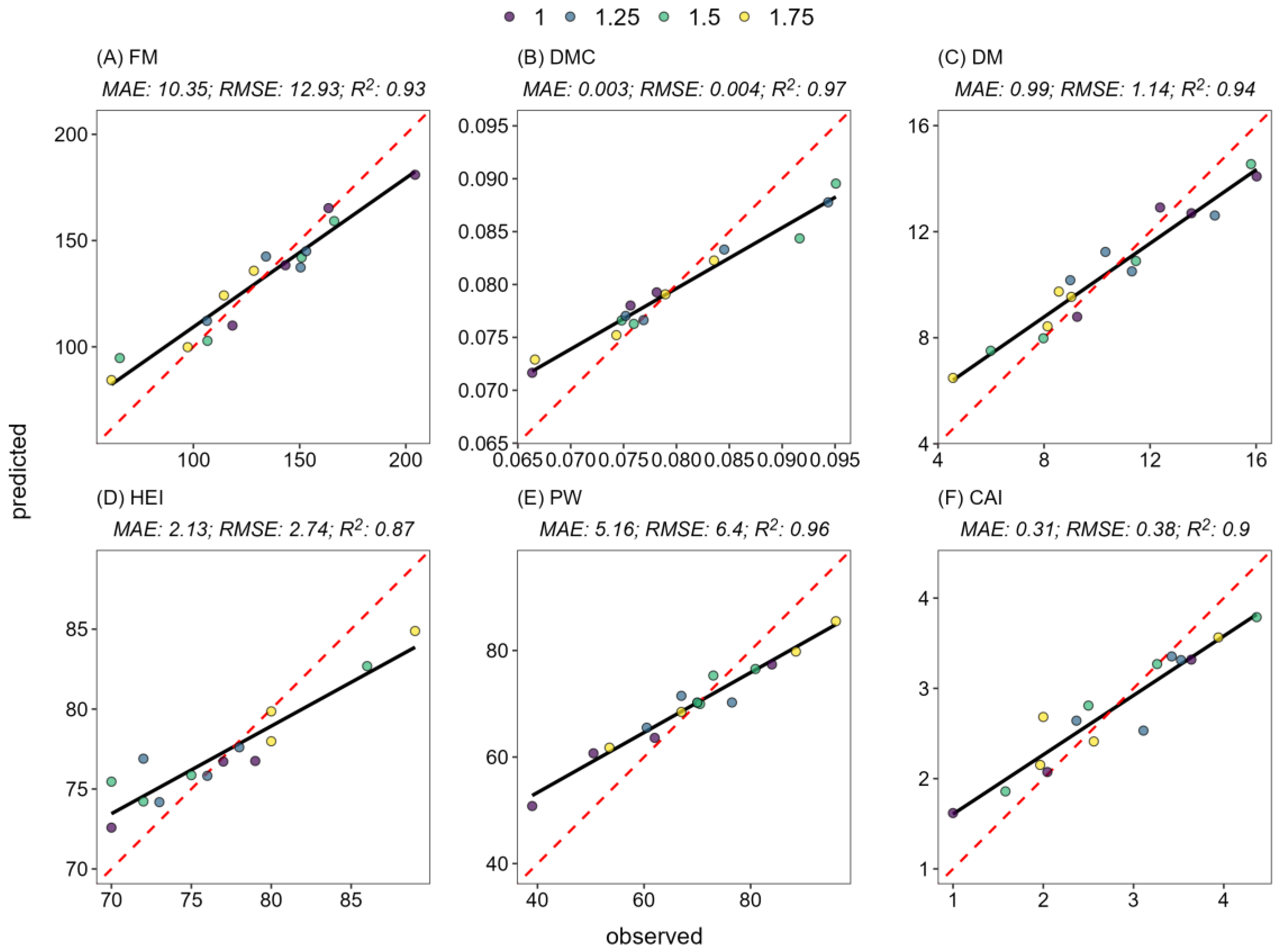

| Index | Acronym | Equation | Reference |
|---|---|---|---|
| Visible Atmospherically Resistant Index | VARI | (G − R)/(G + R − B) | [40] |
| Modified Green–Red Vegetation Index | MGRVI | (G2 − R2)/(G2 + R2) | [41] |
| Green Leaf Algorithm | GLA | ((2 × G) − R − B)/((2 × G) + R + B) | [42] |
| Red–Green–Blue Vegetation Index | RGBVI | (G2 − B × R)/(G2 + B × R) | [43] |
| Green–Red Vegetation Index | GRVI | (G − R)/(G + R) | [43] |
| Excess Red Vegetation Index | ExR | 1.4 × R − G | [44] |
| Excess Blue Vegetation Index | ExB | 1.4 × B – G | [45] |
| Excess Green Vegetation Index | ExG | 2 × G − R − B | [45] |
| Excess Green Red Vegetation Index | ExGR | ExG – ExR | [46] |
| Color Index of Vegetation | CIVE | 0.441 × R − 0.881 × G + 0.385 × B + 18.78745 | [47] |
| Vegetative | VEG | G/(R0.667 × B0.333) | [48] |
| Combination | COM | 0.25 × ExG + 0.3 × ExGR + 0.33 × CIVE + 0.12 × VEG | [44] |
| Kawashima Index | IKAW | (R − B)/(R + B) | [49] |
| Color Intensity Index | INT | (R + G + B)/3 | [49] |
| Vegetation Indices | Maximum | Minimum | Mean | Standard Deviation |
|---|---|---|---|---|
| VARI | 0.031 | −0.139 | −0.076 | 0.033 |
| NGRDI | 0.018 | −0.085 | −0.046 | 0.019 |
| MGRVI | 0.036 | −0.168 | −0.092 | 0.039 |
| GLA | 0.071 | −0.014 | 0.018 | 0.018 |
| RGBVI | −0.940 | −0.987 | −0.970 | 0.012 |
| ExR | 80.72 | 24.13 | 49.60 | 16.00 |
| ExB | 35.15 | 5.216 | 16.72 | 7.364 |
| ExG | 17.39 | −6.594 | 5.000 | 5.397 |
| ExGR | −9.130 | −84.90 | −44.60 | 20.45 |
| CIVE | 16.35 | 7.75 | 12.30 | 1.750 |
| VEG | 1.030 | 0.890 | 0.940 | 0.025 |
| COM | 4.210 | −21.67 | −7.943 | 6.976 |
| IKAW | 0.181 | 0.086 | 0.139 | 0.020 |
| INT | 133.2 | 58.29 | 89.98 | 22.44 |
| Experiment | Experiment Number | mtry | Trees | min_n | Variable |
|---|---|---|---|---|---|
| Plant spacing and orientation | I and II | 3 | 838 | 2 | FM |
| 4 | 669 | 2 | DMC | ||
| 3 | 663 | 2 | DM | ||
| 4 | 669 | 2 | HEI | ||
| 4 | 859 | 2 | PW | ||
| 3 | 597 | 2 | CAI | ||
| Different row spacings | III | 3 | 844 | 3 | FM |
| 4 | 859 | 2 | DMC | ||
| 4 | 669 | 2 | DM | ||
| 3 | 597 | 2 | HEI | ||
| 4 | 859 | 2 | PW | ||
| 3 | 663 | 2 | CAI | ||
| Different cutting frequencies and forage cactus clones | IV | 4 | 859 | 2 | FM |
| 4 | 669 | 2 | DMC | ||
| 3 | 838 | 2 | DM | ||
| 4 | 859 | 2 | HEI | ||
| 3 | 597 | 2 | PW | ||
| 4 | 859 | 2 | CAI |
Disclaimer/Publisher’s Note: The statements, opinions and data contained in all publications are solely those of the individual author(s) and contributor(s) and not of MDPI and/or the editor(s). MDPI and/or the editor(s) disclaim responsibility for any injury to people or property resulting from any ideas, methods, instructions or products referred to in the content. |
© 2024 by the authors. Licensee MDPI, Basel, Switzerland. This article is an open access article distributed under the terms and conditions of the Creative Commons Attribution (CC BY) license (https://creativecommons.org/licenses/by/4.0/).
Share and Cite
Silva, G.I.N.d.; Jardim, A.M.d.R.F.; Santos, W.M.d.; Bezerra, A.C.; Alba, E.; Silva, M.V.d.; Silva, J.L.B.d.; Souza, L.S.B.d.; Marinho, G.T.B.; Montenegro, A.A.d.A.; et al. Estimation of Biophysical Parameters of Forage Cactus Under Different Agricultural Systems Through Vegetation Indices and Machine Learning Using RGB Images Acquired with Unmanned Aerial Vehicles. Agriculture 2024, 14, 2166. https://doi.org/10.3390/agriculture14122166
Silva GINd, Jardim AMdRF, Santos WMd, Bezerra AC, Alba E, Silva MVd, Silva JLBd, Souza LSBd, Marinho GTB, Montenegro AAdA, et al. Estimation of Biophysical Parameters of Forage Cactus Under Different Agricultural Systems Through Vegetation Indices and Machine Learning Using RGB Images Acquired with Unmanned Aerial Vehicles. Agriculture. 2024; 14(12):2166. https://doi.org/10.3390/agriculture14122166
Chicago/Turabian StyleSilva, Gabriel Italo Novaes da, Alexandre Maniçoba da Rosa Ferraz Jardim, Wagner Martins dos Santos, Alan Cézar Bezerra, Elisiane Alba, Marcos Vinícius da Silva, Jhon Lennon Bezerra da Silva, Luciana Sandra Bastos de Souza, Gabriel Thales Barboza Marinho, Abelardo Antônio de Assunção Montenegro, and et al. 2024. "Estimation of Biophysical Parameters of Forage Cactus Under Different Agricultural Systems Through Vegetation Indices and Machine Learning Using RGB Images Acquired with Unmanned Aerial Vehicles" Agriculture 14, no. 12: 2166. https://doi.org/10.3390/agriculture14122166
APA StyleSilva, G. I. N. d., Jardim, A. M. d. R. F., Santos, W. M. d., Bezerra, A. C., Alba, E., Silva, M. V. d., Silva, J. L. B. d., Souza, L. S. B. d., Marinho, G. T. B., Montenegro, A. A. d. A., & Silva, T. G. F. d. (2024). Estimation of Biophysical Parameters of Forage Cactus Under Different Agricultural Systems Through Vegetation Indices and Machine Learning Using RGB Images Acquired with Unmanned Aerial Vehicles. Agriculture, 14(12), 2166. https://doi.org/10.3390/agriculture14122166











